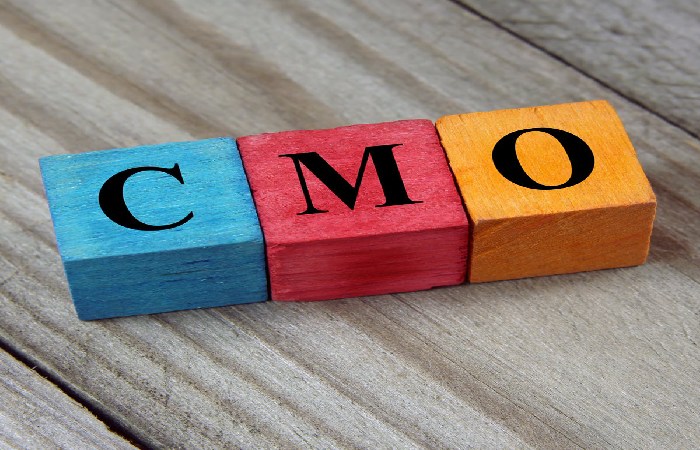Table of Contents
Chief Marketing Officer – Definition
A Chief Marketing Officer is a C-level business executive responsible for the activities of an organization related to the creation, communication, and delivery of offerings that have value for customers or business partners.
The primary role of a CMO remains to facilitate growth and increase revenue by developing a comprehensive marketing plan that builds brand awareness and helps the company gain a competitive advantage. To attain their own goals and effectively shape their company’s public profile, CMOs must be exceptional leaders and make the voice of the customer heard throughout the organization.
Marketing managers typically report to the CEO or chief operating officer (COO) and hold advanced degrees in business and marketing. A CMO with a strong background in information technology can also have the position of chief marketing technology officer (CMT). However, these positions are separate in some large organizations, and the CMT reports to the CMO.
Chief Marketing Officer Job Description
Specifically, the Marketing Director is the executive responsible for developing the company’s branding and advertising strategy and targeting customers. In addition, as the corporate marketing manager, they oversee these functions across all product lines and regions of the company.
This Is The Job Of The CMO:
- understand the company’s position in the market using traditional methods as well as newer technologies such as data analytics;
- determine how and where the company should position itself in the future;
- develop the strategy to lead the organization to that future market position; Yes
- execute this strategy.
- The CMO’s work should produce world-class results, with marketing efforts that increase brand awareness, recognition, and loyalty, ultimately leading to increased revenue.
- The CMO is expected to work closely with (or even lead in some organizations) the sales unit.
Chief Marketing Officer Roles And Responsibilities
- The CMO has a wide range of roles and responsibilities to support its overall mission. It includes:
- Oversee the development and placement of creative elements that position the business in the market;
- research and assessment of the market and the company’s position therein;
- monitor or collaborate with sales to convert marketing information into sales; Yes
- Lead company public relations efforts or work with internal and external public relations teams to create a coordinated message.
Why The Role Of The Chief Marketing Officer Has Grown In Importance
Technological advancements in the 21st century have increased the importance of the CMO position in many governments. The Internet, the ubiquity of mobile calculating, the Internet of Possessions, analytics, artificial intelligence, and social media platforms have created new ways to reach customers and understand their opinions on products, services, and brands.
They’ve also given consumers a new and much bigger voice that can instantly get their opinions across to potentially thousands, if not millions. At the same time, CMOs and their teams can use these technologies to reach and influence customers, position their products, and challenge competitors at the same speed and scale as customers.
As with other C-suite leaders in this new technology-driven business paradigm. The CMO needs to collaborate much more with their C-suite peers to keep pace. CMOS must also adapt and innovate as technologies evolve, and markets change accordingly.
Qualifications
CMOS, who may also hold the vice president of sales and marketing, typically have at least a bachelor’s degree in marketing (although an MBA is often preferred or even required). In addition. They usually have at least a decade of marketing and advertising experience and several years of experience in a leadership position.
They should have strong leadership skills, project development experience, excellent communication skills, and business acumen. Additionally, the CMO role today requires a high level of technical aptitude to maximize tools and leverage social media platforms critical to marketing efforts.
For example, CMOS should monitor the organization’s use of analytics platforms to understand preferences, and priorities.
Why the CMO Role has Gained Prominence
The technological progress of the 21st century has highlighted the importance of the CMO location in many governments. The internet, the ubiquity of mobile adding, the net of gears, analytics, artificial intelligence, and social media platforms have shaped new ways to reach clients and understand their views on products, services, and makes.
They also have given a new, much more projecting voice to consumers who can suddenly broadcast their opinions to thousands, if not millions, of people. At the same time, CMOs and their sides can tap those technologies to reach and affect customers, position their products, and challenge participants at the same speed and scale as the clients.
As with other C-suite executives in this new technology-driven business example, the CMO must collaborate much further with their policymaking peers to keep pace. CMOS also must be capable of edition and innovation as skills evolve and markets shift in response.
The Future of the CMO
Although the technology-driven variations of the past 20 years have high the CMO in many organizations, the position is on rocky grounds in some respects.
Some companies are reshaping their job in response to those same technology forces, removing the CMO role or altering it into jobs like the chief client officer, chief knowledge officer, chief client officer, or chief digital officer. In some companies, the CMO is combined with one of the folk’s other parts.
To this point, Forrester Research Inc., in its 2018 CMO estimates, said more governments would replace their CMOs with chief growth officers.
“The rise of the CGO stands as a rebuke to unimpressive CMO,” Forrester states. “CEOs stressed to lead a force of change during slow growth will bypass many CMOs, looking to install directors with larger remits. For example, for a brand like Coca-Cola, this meant sunsetting the CMO position completely in favor of a CGO, representing a burgeoning trend CMOs can only decrease by leading strategic growth initiatives.”
Skills and knowledge Requirements
- Advanced degree/MBA and 10+ years of Advertising control experience, preferably in a SaaS software or related company
- Strong track record of management, including the ability to hire and mentor a top-performing global marketing team to achieve company revenue objectives
- Previous experience overseeing innovative, cutting-edge corporate and creative marketing metrics-driven programs
- Entrepreneurial mindset, highly respected team actor with a roll-up-your-sleeves work ethic, who is devoted, results-driven, action-oriented, and used to a fast-paced, demanding start-up culture
- Previous answerability leading and managing high growth, metrics-driven marketing organization
- Ability to play a crucial role on the Executive Running team, significantly contributing to the overall corporate strategy and the long-term direction of ABC Company
- Proven ability to thrive in a fast-paced, active, ever-changing, high-growth environment in which cross-functional teamwork and initiative are paramount to attaining success
- Diligent work ethic and the peak equal of honesty and discipline, with a solid drive to exceed goals and achieve the highest standard of excellence
- Superb written and verbal message skills and an established ability to deliver high-impact results
- Strong presentation skills with previous knowledge of speaking actions
- Highly inspirational leader; creative, results-driven, self-motivated, helpful attitude, robust attention to detail, organized, excellent follow-through, practical time management skills with the ability to order, respond to pressure, and meet deadlines
Conclusion
We match top professionals with great bosses across the country. Your next career move or star employee is just about the corner. Review our career satisfaction and information, browse our latest job starts, or email us your resume.
We look forward to linking with you soon!





